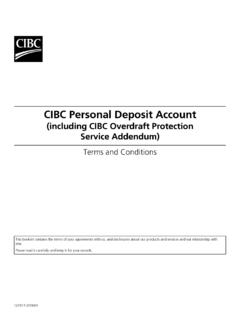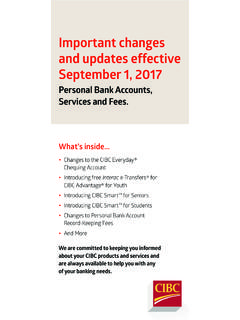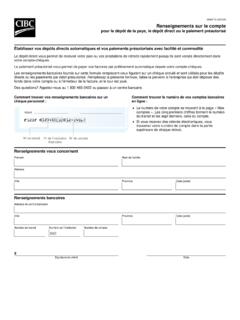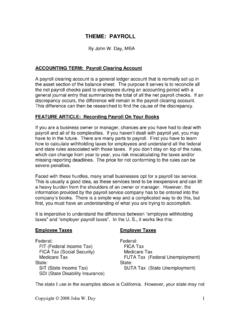Transcription of 2018 Federal Budget - CIBC
1 February 27, 2018 _____ 2018 Federal Budget Jamie Golombek and Debbie Pearl-Weinberg Tax & Estate Planning, CIBC Financial Planning and Advice The February 27, 2018 Federal Budget (the Budget ) included a number of tax measures that will impact Canadian taxpayers. Rather than summarize every tax measure included in the Budget document, this report, which was prepared from within the Budget lock-up in Ottawa, will focus on some of the tax measures that are of most interest to individuals and small business owners. Canadian Controlled Private Corporation (CCPC) Tax Changes: Passive Investment Income In last year s Federal Budget , the government announced that it was conducting a review of tax planning strategies involving private corporations.
2 The Department of Finance released a paper in July 2017 outlining three areas of concern: income sprinkling using private corporations, converting a private corporation s regular income into capital gains and passive investments inside private corporations. The government announced in October 2017 that they were not proceeding with the proposals regarding converting regular income to capital gains. The income sprinkling proposals were revised in December 2017 and detailed ru le s concerning restricting the earning of passive investment income inside a corporation were to be released as part of the 2018 Federal Budget . Last fall, the government stated that investments already made inside of private corporations, including the future income earned from such investments, would be protected.
3 The ru le s w e re t o ap p ly o n ly o n a go-forward basis and the first $50,000 of passive income annually would not be subject to the new rules. During the period of consultation, the government heard that its proposals, which would have taxed investment income inside a corporation at punitive effective tax rates, could be very complex and the tracking of pre- and post-grandfathered assets would add significant administrative burdens on businesses. Consistent with the government s outlined principles and consistent with the helpful contributions of many Canadians in the consultation period, the government decided to take an entirely different approach and instead proposed two new measures to limit deferral advantages from holding passive savings in a corporation, but in a more targeted and simpler manner than was proposed in July 2017.
4 Tax Deferral Advantage The government s concern is that under the current rules, a tax deferral advantage exists because the tax rate on active business income earned in a corporation is generally much lower that the top marginal tax rate for individuals earning business income or employment income directly. If this after-tax corporate business income is not needed for a shareholder s living expenses and is retained in the corporation, t h e re is more after-tax income to be used as capital for investment than there would be if the business income was earned by the 2018 Federal Budget February 27, 2018 2 If these corporate funds are invested for a sufficiently long period of time, shareholders may end up with a higher after-tax amount than if income was earned directly by the individual shareholder and invested in the shareholder s hands, due to the larger amount of starting capital to invest.
5 The purpose of the passive investment income proposals is to remove some of this tax deferral advantage. The size of the tax deferral advantage depends on the difference between the applicable corporate tax rate and the shareholder s personal tax rate. Federally, the first $500,000 of active business income is taxed at the small business deduction tax rate (SBD Rate), which is a lower tax rate than the general corporate tax rate on active business income (ABI); thus, the tax deferral advantage is magnified for small business income and the deferral ranges from to in 2018, as shown in Figure 1. For ABI, the tax deferral advantage ranges from to Figure 1: 2018 Tax Deferral Advantage by Province for SBD Income and ABI SBD Income (eligible for small business deduction) ABI (not eligible for small business deduction) BC AB SK MB ON QU NB NS PE NL The Proposed Rules The Budget proposes two measures to address the tax deferral advantage.
6 The first impacts eligibility for business income to be taxed at the lower SBD Rate. The second measure restricts payouts from the refundable dividend tax on hand (RDTOH) account for larger CCPCs. Both of these measures w o u ld be effective beginning January 1, 2019. Restricting the SBD Rate The SBD Rate currently applies federally on the first $500,000 of qualifying active business income of a CCPC. This is referred to as the Business Limit. The first new measure proposes to reduce the Business Limit for CCPCs with over $50,000 of adjusted aggregate investment income 1 in a year, and to reduce the Business Limit to zero o nce $150,000 of adjusted aggregate investment income is earned in a year. E s s e n t ially, in certain circumstances this proposed measure will limit the tax deferral advantage available on new ABI to the difference between the personal tax rate on ordinary income and the tax rate on ABI earned in a corporation that is not eligible for the SBD Rate.
7 Figu re 2 illustrates the interaction between adjusted aggregate investment income and the impact on the Business Limit. Figure 2: Reduction in the Small Business Deduction Limit Based on Passive Investment Income Source: Finance Canada, Budget Plan 2018 CIBC 2018 Federal Budget February 27, 2018 3 Examples of New Passive Investment Income / SBD Limitation Rules The following examples are adapted from the 2018 Budget Plan and demonstrate how the new rules may affect a small business owner in 2019. E xamp le 1 Elise owns an incorporated catering business which earns $100,000 (after tax) annually and pays out $75,000 as non-eligible dividends each year. She retains the extra $25,000 annually to build up a fu n d fo r a p lan n e d p are n t al le av e.
8 E lis e w ill n o t b e affected by the new rules since the investment income on her savings will be well below the $50,000 annual threshold. Thus, she will have no income taxed at the general corporate rate. E xamp le 2 Simon is an incorporated farmer who puts aside excess funds annually to manage weather and other risks affecting his livelihood. His goal is to save $500,000. He chooses to save through his corporation in the A griInvest program to take advantage of matching government contributions. Investment income from AgriInvest is not considered adjusted aggregate investment income. As such, Simon will not be affected by the new ru le s . E xamp le 3 Claire owns a retail business and now uses the retained earnings in her corporation to invest in promising start-ups.
9 She recently sold a 20-per-cent stake in a growin g cle an-tech firm, and realized a $1 million capital gain, which she reinvested into two new start-up s . Claire als o won t be affected by the new rules because her ownership stake in the active business she just sold is such that her capital gain will not count towards the $50,000 threshold, and she is actively reinvesting. E xamp le 4 Amrita owns a hotel whose income depends on a number of factors outside her control, so she sets aside funds each year to ensure she can continue to pay salaries and expenses in case of a downturn. She has $400,000 in savings in her corporation that she invests in low-risk bonds. Amrita will not be affected by the new rules because the investment income on her savings will be well below the $50,000 threshold, and therefore she won t have business income taxed at the general corporate rate.
10 E xamp le 5 Saanvi owns a retail store and keeps cash deposits to pay her suppliers and the salary of her employee. She earns interest income on these deposits, which in her circumstances is considered incidental to her business. As a result, Saanvi will not be affected by the new rules. E xamp le 6 Louis operates a successful medical practice, which is incorporated and earns more than $500,000 annually. He has accumulated a portfolio with a value of $5 million, which he intends to pass on to his children. Given his level of savings and level of income, beginning in 2019, Louis will no longer receive the benefit of the small business rate to fund further passive investments. All of his business income will be taxed at the general corporate rate.












